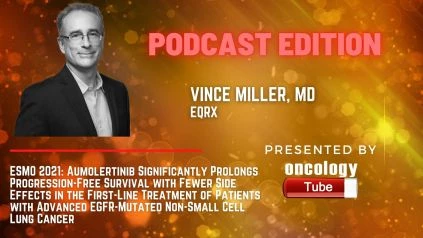Vince Miller, MD is one of the world’s experts in lung cancer and clinical trial design and interpretation. His work was critical to identification of EGFR sensitizing and resistance mutations, Physician-in-Chief at EQRx speaks about the ESMO 2021 Abstract – Aumolertinib Significantly Prolongs Progression-Free Survival with Fewer Side Effects in the First-Line Treatment of Patients with Advanced EGFR-Mutated Non-Small Cell Lung Cancer.
Background: Au is a potent, irreversible epidermal growth factor receptor tyrosine kinase inhibitor (EGFR TKI) that specifically suppresses both EGFR sensitizing and resistance mutations. In China, Au has been authorized for the treatment of patients with EGFR mutant NSCLC with EGFR T790M who have progressed on prior EGFR TKIs (Proc. AACR 2020, Abstract CT190). The effectiveness and safety of Au vs G as the first therapy for individuals with advanced NSCLC with EGFRm were compared in this Phase III study.
Methods:
Patients with previously untreated metastatic or locally advanced NSCLC with EGFR exon 19 deletion or L858R were randomly allocated to receive either Au (110 mg once daily) or G (100 mg once daily) in a 1:1 ratio (250 mg once daily). Per investigator judgment, the main outcome was progression-free survival (PFS) as measured by RECIST v1.1. The research showed 90 percent power to identify a PFS HR = 0.67 with 262 PFS occurrences. Overall survival (OS), objective response rate (ORR), duration of response (DoR), and safety were all secondary goals.
Results:
Between November 30, 2018, and September 6, 2019, 429 patients were recruited and randomized across 53 locations in China. Characteristics of the pt. were well-balanced. Au substantially extended PFS (median 19.3 vs 9.9 months, HR 0.46, p-value 0.0001) in the intended final event-driven PFS analysis. With Au, DoR was also considerably extended. The median OS has yet to be determined. The table summarizes the efficacy and important safety findings. Au was linked with a reduced frequency of dermatitis, diarrhea, AST/ALT rise, and therapy-related severe adverse events (SAEs) despite a considerably longer treatment period (median 463 vs 254 days) (4.2 percent vs 11.2 percent ). CPK rose, platelet count reduced, and neutrophil count fell, all of which were largely low-grade occurrences, were all linked to Au.
Conclusions:
In patients with advanced NSCLC with EGFRm, Au dramatically improved PFS and DoR when compared to G as first-line treatment. Au had a good safety profile, especially when it came to toxicities caused by wild-type EGFR. These findings suggest that Au may be a viable treatment choice for advanced NSCLC patients with EGFR mutations. NCT03849768 is the number for the clinical study.

